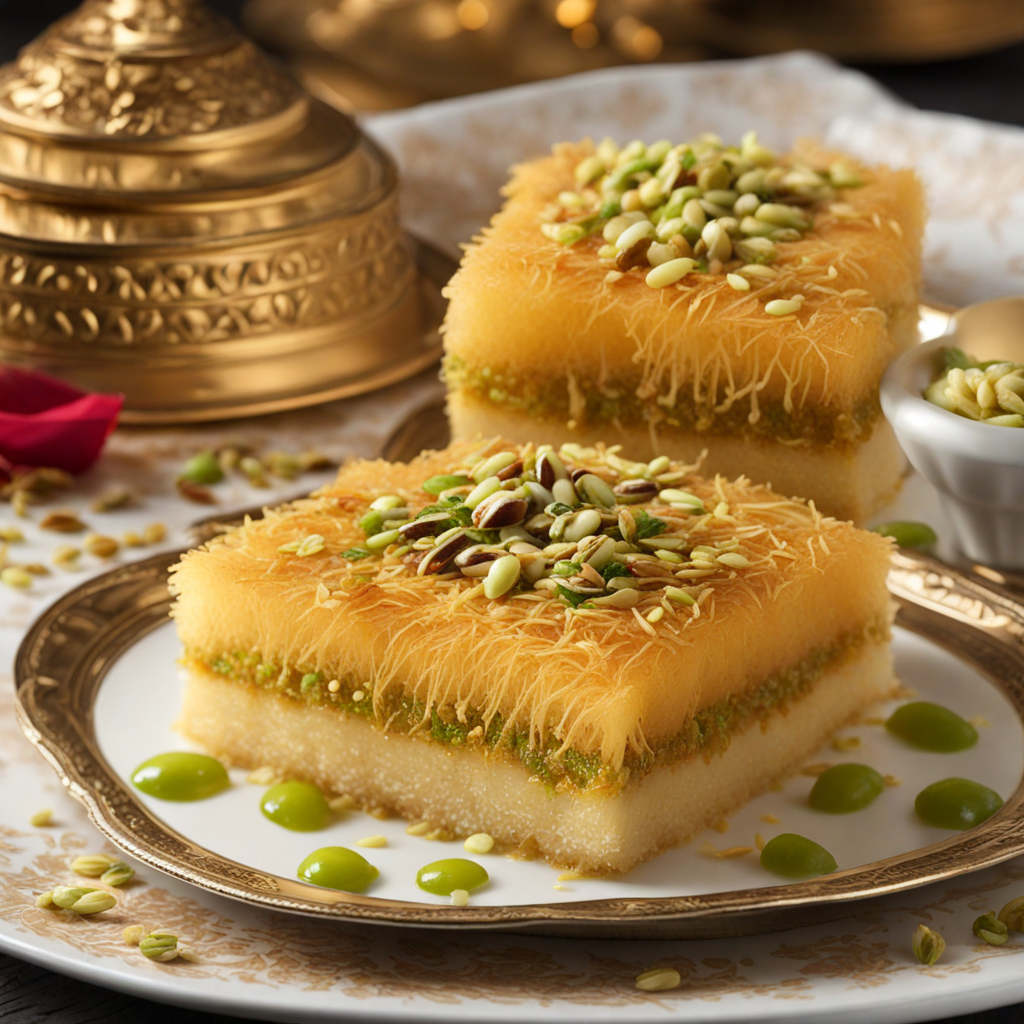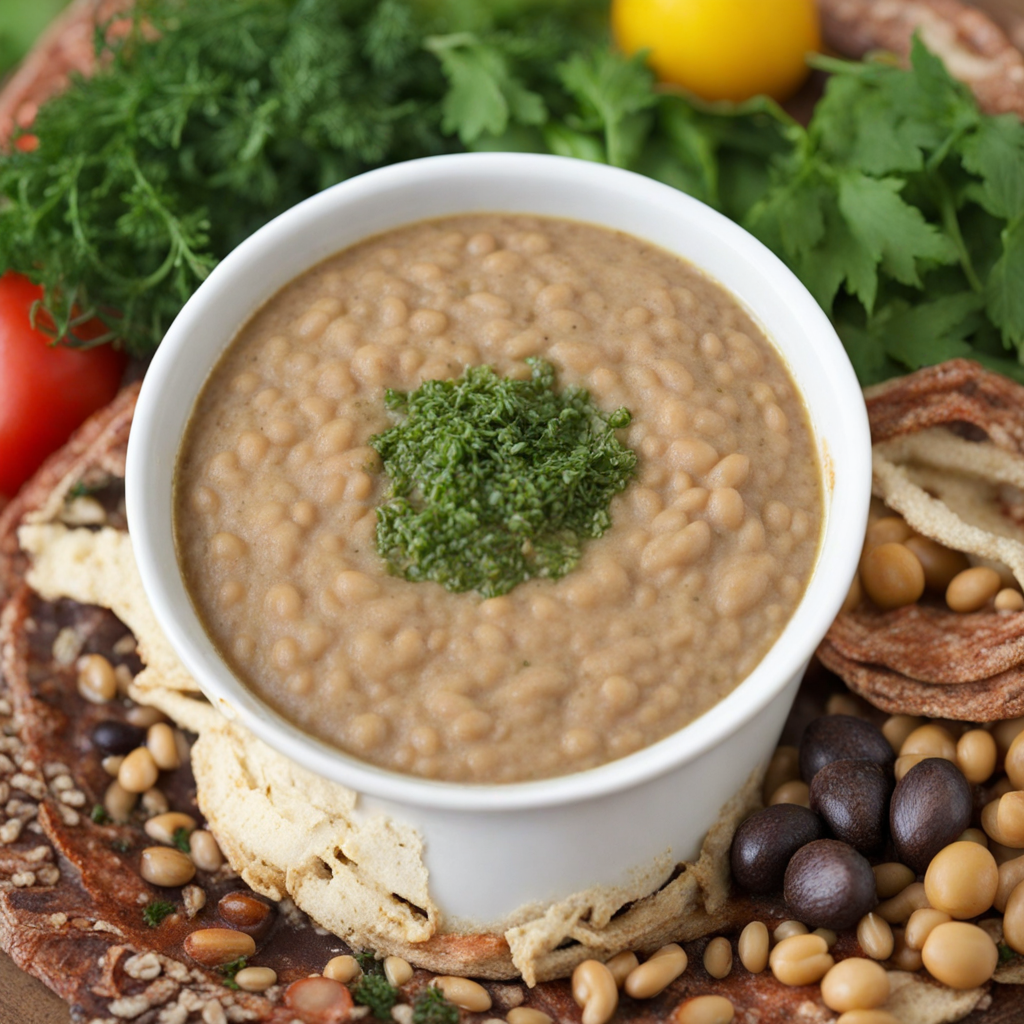Umm Ali
Umm Ali is a delightful Egyptian dessert that embodies the essence of comfort food. This rich, creamy dish is akin to a bread pudding, showcasing layers of flaky pastry, typically made from khus khus or puff pastry, soaked in a luxurious mixture of milk and sugar. The pastry is baked to golden perfection, giving it a delightful crunch that contrasts beautifully with the silky texture of the custard-like filling. The combination of these textures creates a unique mouthfeel that is both satisfying and indulgent, making it a beloved treat in Egyptian households. What truly sets Umm Ali apart are the aromatic spices and nuts that enhance its flavor profile. Traditionally, this dessert is infused with a hint of vanilla and sometimes a touch of cinnamon, which adds warmth and depth to the dish. Chopped almonds, pistachios, and raisins are often sprinkled throughout, providing not only a delightful crunch but also a burst of sweetness that complements the creamy base. Each spoonful offers a symphony of flavors, with the nuttiness of the almonds and the chewiness of the raisins harmonizing perfectly with the rich, sweet milk. Umm Ali is typically served warm, allowing the flavors to meld together beautifully, creating a comforting experience reminiscent of home. It's often enjoyed during special occasions and gatherings, making it a staple in festive celebrations. Whether you’re indulging in a bowl on a chilly evening or sharing it with friends and family during a feast, Umm Ali promises a taste of Egypt that is both heartwarming and unforgettable.
How It Became This Dish
The History of Um Ali: A Sweet Legacy from Egypt Origins of Um Ali Um Ali, or "Mother of Ali," is a traditional Egyptian dessert that has captured hearts and palates across the Arab world. Its origins can be traced back to the Mamluk period in Egypt during the 13th century, a time marked by political intrigue and cultural flourishing. The dessert is often associated with a queen named "Um Ali," the wife of Sultan Ezz al-Din Aybak, and while historical records are scant, the legend surrounding its creation adds a rich narrative to its culinary identity. The story goes that after the death of Sultan Aybak, his wife Um Ali sought to assert her position and ensure her son’s claim to the throne. In a bid to rally support and celebrate her son Ali, she created this delightful dish, a combination of bread, milk, nuts, and sugar, which appealed to the senses and brought people together. The dessert quickly became a symbol of hospitality and generosity, serving as a reminder of Um Ali’s determination and ingenuity. Cultural Significance Um Ali is more than just a culinary delight; it is a dish steeped in cultural significance. In Egypt, it is often served during special occasions such as weddings, Ramadan, and family gatherings. The preparation and sharing of Um Ali embody themes of unity and celebration, making it a staple at festive feasts. The dish is usually prepared in large trays, allowing families and friends to partake in this communal experience. Furthermore, Um Ali has transcended its royal origins to become a beloved dessert in everyday Egyptian life. It symbolizes the warmth of family gatherings and traditional celebrations, fostering a sense of belonging and continuity. The dessert also highlights the importance of hospitality in Egyptian culture, where serving food is a way of expressing love and care. Ingredients and Preparation The beauty of Um Ali lies in its simplicity and versatility. Traditionally, the dish is made using layers of torn pieces of pita bread or croissant, soaked in a mixture of milk, sugar, and vanilla. It is then topped with a variety of nuts such as almonds, pistachios, and walnuts. Some recipes incorporate raisins or coconut, while others might add a hint of cinnamon or cardamom for extra flavor. The preparation involves baking the layered ingredients in the oven until golden brown and crispy, allowing the flavors to meld together harmoniously. The result is a warm, creamy dish with a delightful crunch from the nuts—a texture that keeps eaters coming back for more. Evolution Over Time Over the centuries, Um Ali has evolved, with regional variations emerging across the Arab world. In Egypt, the dish remains true to its roots, but other countries have adopted the concept and infused it with local flavors and ingredients. For instance, in Syria and Lebanon, the dessert may feature different types of bread or additional spices, creating a unique twist on the classic recipe. In contemporary Egypt, Um Ali has found its way into restaurants and cafes, where chefs experiment with presentation and ingredients. Gourmet versions may include luxurious elements such as saffron or artisanal pastries, elevating the dish to new culinary heights. Despite these innovations, the essence of Um Ali as a comforting and nostalgic dessert remains intact. Global Influence and Modern Adaptations As globalization has spread culinary traditions across borders, Um Ali has gained popularity beyond its Egyptian origins. The dish has made its way into the Middle Eastern diaspora, appearing in restaurants and homes in places like Europe, North America, and even Australia. Chefs and home cooks alike have embraced Um Ali, sharing their interpretations while preserving its core attributes. In recent years, the rise of social media has played a significant role in popularizing traditional dishes like Um Ali. Food bloggers and influencers showcase their versions of the dessert, often accompanied by stunning visuals and heartfelt stories about their connection to the dish. This has not only revived interest in Um Ali but has also encouraged younger generations to explore their culinary heritage. Um Ali in Contemporary Egyptian Society In modern Egyptian society, Um Ali continues to hold a cherished place at the table. It is often served at family gatherings, holidays, and celebrations, acting as a bridge between generations. Grandmothers pass down their secret recipes to daughters and granddaughters, ensuring that the legacy of this beloved dessert lives on. Moreover, Um Ali is increasingly viewed as a symbol of Egyptian culinary identity, standing alongside other iconic dishes such as koshari, mahshi, and molokhia. It serves as a reminder of Egypt’s rich history and diverse cultural influences, bringing together flavors and techniques from various regions and eras. Conclusion Um Ali is a dessert that embodies the spirit of Egypt—a blend of history, culture, and community. From its royal origins to its place in modern Egyptian kitchens, Um Ali has transcended time and space, connecting people through shared experiences and flavors. As it continues to evolve and adapt to contemporary tastes, the essence of Um Ali remains a testament to the enduring power of food to tell stories, create bonds, and celebrate life’s moments. Whether enjoyed in a bustling Cairo café or a family home during festive occasions, Um Ali is more than just a dessert; it is a sweet legacy that continues to inspire and delight.
You may like
Discover local flavors from Egypt







